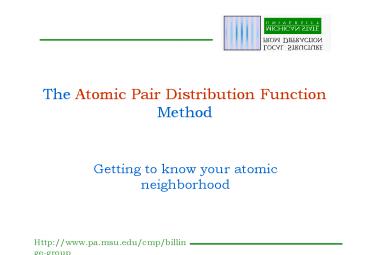The Atomic Pair Distribution Function Method - PowerPoint PPT Presentation
1 / 7
Title:
The Atomic Pair Distribution Function Method
Description:
We extract information from the PDF by fitting structural models to the data. We use Full-profile least-squares fitting of the PDF using the program PDFfit ... – PowerPoint PPT presentation
Number of Views:265
Avg rating:3.0/5.0
Title: The Atomic Pair Distribution Function Method
1
The Atomic Pair Distribution Function Method
- Getting to know your atomic neighborhood
2
Inroduction
- Modern materials are often disordered.
- Standard crystallographic methods lose the
aperiodic (disorder) information. - We would like to be able to sit on an atom and
look at our neighborhood. - The PDF method allows us to do that (see next
slide) - First we do a neutron or x-ray diffraction
experiment - Then we correct the data for experimental effects
- Then we Fourier transform the data to real-space
3
Obtaining the PDF
Structure function
Raw data
4
What is the PDF?
- (a) The red ball is a C60 molecule. C60 forms a
solid by the molecules clustering (b). The
scattering and PDF are shown in (c) and (d)
respectively. - Sit on an atom and look at your neighborhood.
The nearest neighbor is at 1.4A distance, the
second neighbor at 2.2A and so on. There are
sharp peaks in G(r) at these positions. This is
the structural information in the PDF. - There are no sharp peaks beyond 7.1A, the
diameter of the ball because the balls are
spinning with respect to each other. The PDF can
see this.
5
Full Profile PDF fitting using PDFFIT
- We extract information from the PDF by fitting
structural models to the data - We use Full-profile least-squares fitting of the
PDF using the program PDFfit - The red line is the PDF from the model, the blue
line the data, the green line the difference. - The data are neutron data from LaMnO3 collected
10K at IPNS, Argonne National Laboratory, IL. - Ref Proffen et al., Phys. Rev. B 60, 9973 (1999).
6
Observing Domains in the PDF
The PDF gives different information on different
length-scales. We can see the structure within
a domain at low-r and between domains at high-r.
7
Goodbye
- Please look elsewhere on the web-page, or check
our publication list, to see the ways we are
applying the PDF to learn about materials. - Thanks for the visit!































